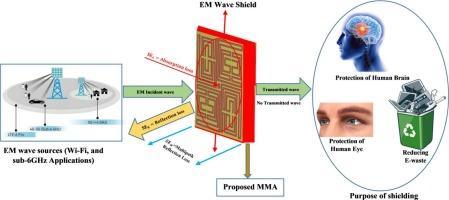Rotational symmetric metamaterial structure of emblemed number connected with continuous transmission line for EM wave shielding applications
IF 5.4
2区 工程技术
Q1 ENGINEERING, MULTIDISCIPLINARY
Engineering Science and Technology-An International Journal-Jestech
Pub Date : 2025-10-09
DOI:10.1016/j.jestch.2025.102200
引用次数: 0
Abstract
Electromagnetic (EM) wave shielding in modern wireless systems encounters critical challenges, including polarization insensitivity, broadband operation, and compact design requirements. This work introduces a rotationally symmetric metamaterial absorber featuring emblem-shaped continuous transmission line resonators, specifically engineered to achieve high-efficiency absorption across the C, X, and Ku bands. The proposed design demonstrates remarkable absorption rates of 96.77 %, 99.68 %, 99.68 %, 99.70 %, 98.03 %, 99.68 %, and 99.98 % at resonance frequencies of 5.834 GHz, 7.192 GHz, 7.766 GHz, 10.65 GHz, 14.038 GHz, 15.34 GHz, and 15.62 GHz, respectively. Benefiting from rotational symmetry, the absorber maintains complete insensitivity to both co- and cross-polarized incident waves, with stable performance under oblique angles up to 90°. A maximum shielding effectiveness of 78 dB is achieved at the targeted frequencies, ensuring robust protection against EM interference. The compact unit cell (0.233λ × 0.233λ) exhibits near-zero permittivity, permeability, and refractive index with single-negative properties, further supporting efficient absorption within a minimal footprint. To validate the physical behavior, an equivalent RLC circuit model was developed in ADS, showing excellent agreement with CST simulations. Experimental verification using fabricated prototypes and Vector Network Analyzer measurements confirms the strong consistency between simulated and measured results. The novelty of this work lies in the integration of an emblem-shaped resonator with a continuous transmission line in a rotationally symmetric layout, enabling broadband absorption, polarization, and angle insensitivity, as well as high shielding effectiveness within a compact geometry. These features make the proposed absorber highly suitable for Wi-Fi, 5G, aerospace, defense radar, and stealth EM shielding applications.

连接连续传输线的带符号数旋转对称超材料结构,用于屏蔽电磁波
现代无线系统中的电磁(EM)波屏蔽面临着严峻的挑战,包括极化不敏感、宽带操作和紧凑的设计要求。这项工作介绍了一种旋转对称的超材料吸收器,具有徽章形状的连续传输线谐振器,专门设计用于实现C, X和Ku波段的高效吸收。在5.834 GHz、7.192 GHz、7.766 GHz、10.65 GHz、14.038 GHz、15.34 GHz和15.62 GHz的谐振频率下,系统的吸收率分别为96.77%、99.68%、99.68%、99.70%、98.03%、99.68%和99.98%。得益于旋转对称,吸收器对共极化和交叉极化入射波保持完全不敏感,在倾斜角度达90°时性能稳定。在目标频率下达到78 dB的最大屏蔽效率,确保对EM干扰的强大保护。紧凑的单晶电池(0.233λ × 0.233λ)具有接近零的介电常数、磁导率和单负折射率,进一步支持在最小的占地面积内有效吸收。为了验证物理行为,在ADS中开发了等效RLC电路模型,与CST仿真结果非常吻合。利用制造的样机和矢量网络分析仪的测量结果进行实验验证,证实了模拟结果和测量结果之间的强一致性。这项工作的新颖之处在于在旋转对称布局中集成了带有连续传输线的符号形谐振器,实现了宽带吸收、极化和角度不敏感,以及紧凑几何结构内的高屏蔽效率。这些特性使得该吸收器非常适合于Wi-Fi、5G、航空航天、国防雷达和隐身电磁屏蔽应用。
本文章由计算机程序翻译,如有差异,请以英文原文为准。
求助全文
约1分钟内获得全文
求助全文
来源期刊

Engineering Science and Technology-An International Journal-Jestech
Materials Science-Electronic, Optical and Magnetic Materials
CiteScore
11.20
自引率
3.50%
发文量
153
审稿时长
22 days
期刊介绍:
Engineering Science and Technology, an International Journal (JESTECH) (formerly Technology), a peer-reviewed quarterly engineering journal, publishes both theoretical and experimental high quality papers of permanent interest, not previously published in journals, in the field of engineering and applied science which aims to promote the theory and practice of technology and engineering. In addition to peer-reviewed original research papers, the Editorial Board welcomes original research reports, state-of-the-art reviews and communications in the broadly defined field of engineering science and technology.
The scope of JESTECH includes a wide spectrum of subjects including:
-Electrical/Electronics and Computer Engineering (Biomedical Engineering and Instrumentation; Coding, Cryptography, and Information Protection; Communications, Networks, Mobile Computing and Distributed Systems; Compilers and Operating Systems; Computer Architecture, Parallel Processing, and Dependability; Computer Vision and Robotics; Control Theory; Electromagnetic Waves, Microwave Techniques and Antennas; Embedded Systems; Integrated Circuits, VLSI Design, Testing, and CAD; Microelectromechanical Systems; Microelectronics, and Electronic Devices and Circuits; Power, Energy and Energy Conversion Systems; Signal, Image, and Speech Processing)
-Mechanical and Civil Engineering (Automotive Technologies; Biomechanics; Construction Materials; Design and Manufacturing; Dynamics and Control; Energy Generation, Utilization, Conversion, and Storage; Fluid Mechanics and Hydraulics; Heat and Mass Transfer; Micro-Nano Sciences; Renewable and Sustainable Energy Technologies; Robotics and Mechatronics; Solid Mechanics and Structure; Thermal Sciences)
-Metallurgical and Materials Engineering (Advanced Materials Science; Biomaterials; Ceramic and Inorgnanic Materials; Electronic-Magnetic Materials; Energy and Environment; Materials Characterizastion; Metallurgy; Polymers and Nanocomposites)
 求助内容:
求助内容: 应助结果提醒方式:
应助结果提醒方式:


